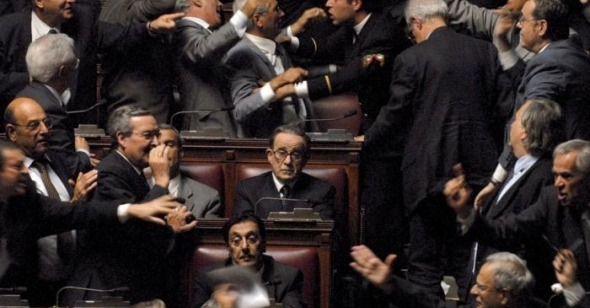Out for Blood
by Michael Koresky
Il Divo
Dir. Paolo Sorrentino, Italy, Music Box Films
In America, we’re used to political biopics with subjects chosen for one of two reasons: to humanize an otherwise historically reviled figure (as Oliver Stone attempted with Nixon and W) or to just retrace an already existent halo around his or her head (hagiographies as varied as Young Mr. Lincoln and Milk come to mind). That’s why Paolo Sorrentino’s Il Divo, a dark-hued treatment of Italy’s infamous prime minister Giulio Andreotti, might come as a surprise to audiences here. Some generous, and historically uninitiated, viewers (i.e., most non-Italians who see this alternately obscure and glib film) will prescribe its presentation of Andreotti’s withering days of power as something of a “national exorcism.” But Sorrentino’s seeming motivation for telling the story of this grandiosely corrupt politician is not to humanize but to trap. And under the pulverizing cinematic techniques of this ecstatically unforgiving filmmaker, this powerful, loathed world leader is little more than a squashed bug.
Not that the scheming, steely Andreotti needs to be pitied, and not that this film, despite its whiz-bang mannerisms and gut-punch stylization, probably had much effect on him at all (perhaps its grotesque exaggerations gave him a chuckle), but Il Divo seems, to these foreign eyes, an unnecessarily demonic affair, and the heavy thumb that Sorrentino keeps on his characters often makes his drama inert. Hardly fashioning himself after an incisive sociopolitical realist like Francesco Rosi, Sorrentino rather appears to imagine himself a millennial stylist along the lines of Fernando Meirelles or Park Chan-wook, albeit with an eye fixed on national identity. As evidenced by its fanciful, howling sub-title, “The Spectacular Life of Giulio Andreotti,” and the Guy Ritchie–esque speed with which flashes of violent death are flung at the screen in its opening minutes, Il Divo practically begs to be called “kinetic.” Then again, the film’s insistent visual nimbleness is initially welcome, as the daunting outpouring of information that comprise much of the film—the names and events that make up the case of corruption the state finally used to bring Andreotti to justice in the early Nineties—threatens to overwhelm the viewer in impalpability.
As Andreotti, introduced in 1991 just as he begins his seventh term, Toni Servillo (last seen on these shores in wildly different form as Gomorrah’s smooth-talking toxic waste–managing huckster) curls inward: clutching his fingers together above his chest and seemingly floating along the floors of his cavernous mansion, this Andreotti is clearly modeled after none other than Nosferatu, and Sorrentino responds with angles and lighting expressionist enough to stir Caligari from his slumber. The businessmen, legislators, and cardinals who make up the Christian-Democratic 7th Andreotti government are likewise introduced with flourish, each framed with slow-motion, Scorsesean delectation, their names and titles bulleted onscreen. With its scenes of bodyguarded prowls down Rome’s empty streets en route to late-night church confessions, its fetishistic straight-razor shaves, its super close-up reflections in cat’s eyes, it’s clear that Il Divo aims more for baroque horror than straight political bio. Andreotti is even haunted by a ghost of sorts: that of Aldo Moro—the left-wing former prime minister kidnapped and assassinated by the Red Brigades in 1978, and for whom Andreotti refused to negotiate—an apparition and manifestation of his guilt. And for a while the film’s evil elegance works: the swoony steadicam shots through his labyrinthine quarters and classical, centered, almost fascistic framing emphasizing grand moral dissolution.
But then, as the graphically depicted suicides and assassinations pile up, Sorrentino’s capital-S style begins to feel like an end in itself. By the third or fourth insert of a ghostly Aldo Moro, every canted frame and swooping camera move strikes as empty affectation. Il Divo is not the story of a downfall but rather a repetitive expression of monolithic power, told somewhat literally, and its rigorous aesthetic grows increasingly, maybe even appropriately, oppressive (perhaps it aspires to heights of Richard III grandeur, but the film’s psychological hesitancy keeps it away from tragic territory). Sorrentino makes every moment, from quicksilver mafia hits to long takes of Andreotti and his wife watching a Renato Zero concert on TV, uniformly emphatic, which results in a fair amount of tedium. In his quest to visually electrify history, Sorrentino only manages to further fog the lens of an already opaque series of recent events.
